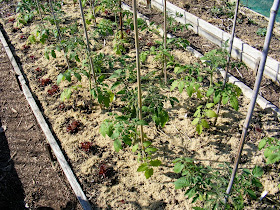With multiple varieties at hand this year, there is the obvious opportunity to encourage some crossing with the hope of selecting for reduced day-length sensitivity. It's new ground for me, but armed with a recently purchased copy of Carol Deppe's 'Breed Your Own Vegetable Varieties', and having learned of the picky outbreeding ways of Oca on the Radix website, I feel ready to give it a go.
My limited stock of new varieties needs to be multiplied up for a planned variety trial next year, so this year they can be grown mixed closely together in one bed to maximise the opportunity for natural and assisted cross-fertilisation. Lets just hope there will be some simultaneous multi-variety flowering, and bees that know about Oca stylar morphs! Otherwise it's going to be knee-pads, tweezers and magnifying glass.
(Below) Here they are laid out for planting. I'm using a slightly denser pattern than previously - two staggered rows of Oca down the centre of the bed.

The bed still has to earn its keep, so once the warm weather arrives cordon tomatoes are added either side, and a quick row of plug-grown red lettuce seedlings along each edge makes full use of the space.
I had a bag of builders sand lying around, so I've scattered it on the surface to reflect light up to the toms, which have been suffering in an overcrowded greenhouse for too long. Here's the view on 21/5/10:

There is a very brief flurry of flowers from one variety in early June (see 'Early Sprouter, Early Flowerer'), then nothing until the 19th of September when one of the variety 'White' produces a flower or two. Conditions were obviously then right, because all of the 'White' plants started to bloom wholesale.
Up until very recently it has been generally accepted that a single Oca variety cannot self-pollinate, but leading-edge events seem to undermine this belief.
Taking this in to account, even though I have only one variety in flower at this stage, I think it is worth the effort to bag a few of the flowers just in case I can collect some seed.
Bagging is required because Oca has a very effective seed dispersal strategy - exploding seed pods.
There's been heavy rain and strong winds, so I've tethered the bags to wire pegs to make sure I can retrieve them all.
Despite the change in the weather, there still seem to be plenty of pollinators at work, so no need for manual methods yet. I watched this chap systematically visiting every Oca flower along the bed before he headed off towards some squash flowers.
30/9/10 The really good news is that I can see flowers buds developing on three more varieties : pale pink/purple eyes,
gold/purple eyes, and white/pink eyes.
Another week, and I'll have potential for some crossing action!
Now, if it would just stop raining ...
20/10/10 Drat! Frost kills all plants. No ripe seed obtained.



If you've got compatible varieties, the weather is right (not too hot or the flowers drop off) and plenty of hoverflies and bumblebees, then success must be a distinct possibility. Bag or collect the pods before they dehisce. A needle in a haystack is nothing compared to finding scattered oca seeds on the soil. Good luck.
ReplyDeleteThanks for the encouragement and advice Rhizowen. My main concern is that there will not be enough flowers. Last year my plants only got a couple all season, but I notice one of your varieties had masses of flowers. Just down to the variety I presume, so let's hope I have one or two like that.
ReplyDeleteThe muddy knees, tweezers and eye-strain is the fun part! And Carol Deppe's book is both inspiring and addictive. I'm sure you're going to have a lot of fun with your hybrid experiments. Here's hoping you get plenty of flowers this year.
ReplyDelete